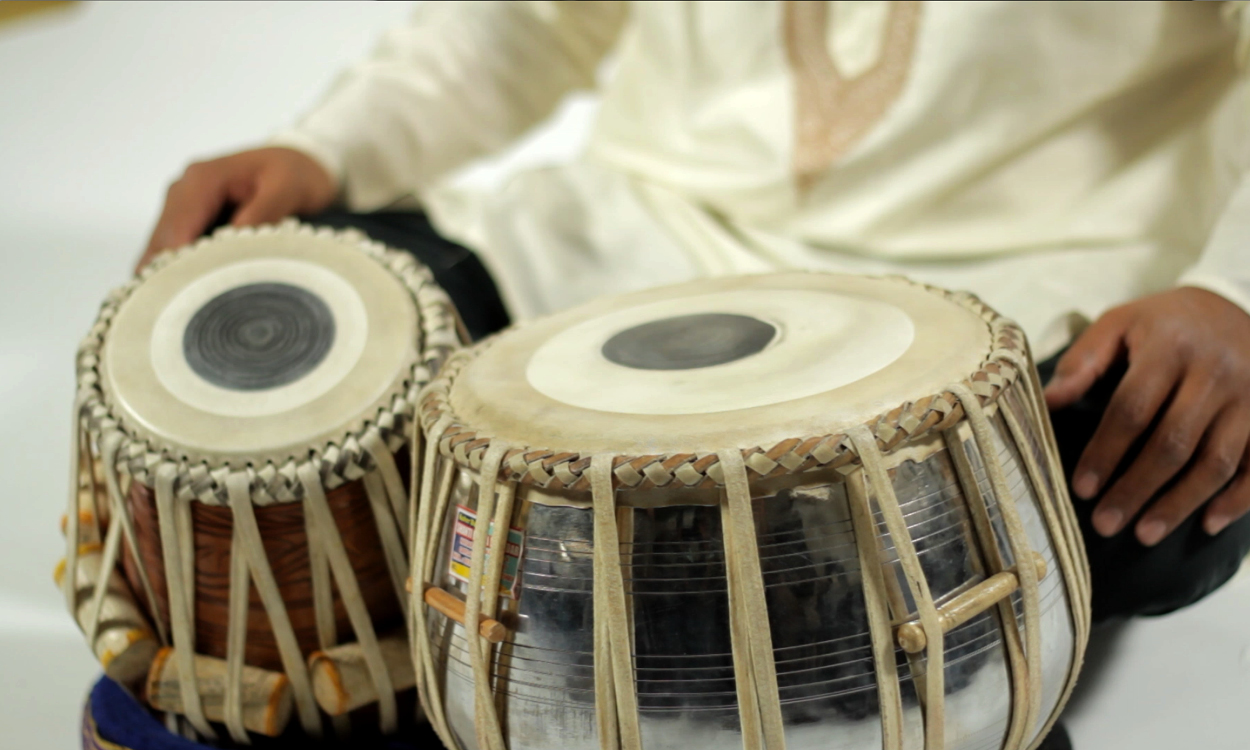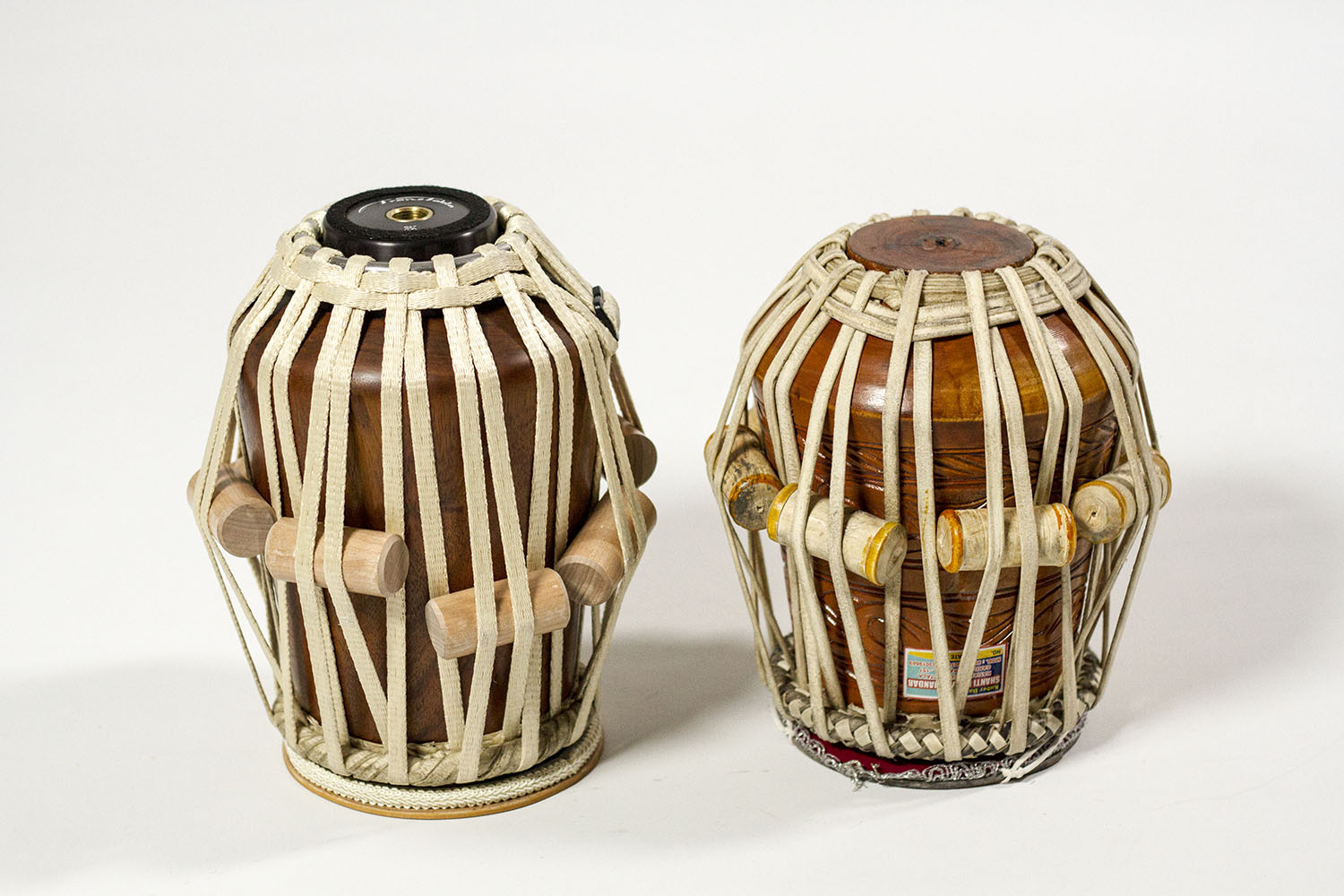BY DAVID YOVINO | FROM THE FALL 2018 ISSUE OF DRUM!
You don’t need to be a tabla master or have access to Abbey Road Studios to appreciate what has been called the most expressive drum in the world. Though The Beatles are largely responsible for popularizing the sound in Western music, there’s a lot to love about the beautiful and unique instrument beyond the nostalgic flower power of the ’60s. After stripping away some of the mystery surrounding these drums, you might even want to try them for yourself.
Legend has it the tabla was born 500 years ago in India when a larger, two-headed drum was dropped and broken into two pieces. Modern ethnomusicology shows evidence of tabla as far back as 13th-century Persia. Either way, it wasn’t until about 50 years ago that Western ears were introduced to the sound, thanks largely to George Harrison and The Beatles.
Before then, Western audiences got a taste of tabla thanks to maestro Ali Akbar Khan’s landmark 1955 album Music Of India: Morning And Evening Ragas, the first Indian classical music album released in the West, featuring Chatur Lal on tabla.
TABLA FOR TWO
Tabla is the name of the instrument, but since it’s usually played as a pair it’s also the name for a set of two drums. The lower-pitched bayan is a copper or clay drum with a 10” head, and the higher-pitched dayan is a wooden drum with a 6” head.
Each has a multi-layered animal skin drumhead that is laced with rawhide strap under tremendous tension, and makes a bell-like tone with long sustain thanks to the metal used in the gab, the black center of each drumhead. The bayan is played with the non-dominant hand, and the dayan is played with the dominant hand. These names translate to “left” and “right” in Bengali, respectively.
TALKIN’ DRUMS
Drumming is a language, and tabla has a wide and complex vocabulary. There are about 30 different tones, or bols, the tabla can produce. Every sound has a name, which the player recites in a way that mimics the actual sound of the drums.
This tradition of vocalization and phrasing of rhythm is part of what makes tabla so versatile, and allows professionals to play comfortably with any type of music. Steve Smith, for example, is known to play blistering jazz on drum set while reciting tabla bols on a headset mike, effectively allowing him to speak in two drumming languages at once.

As Swapan Chaudhuri, director of percussion at the Ali Akbar College of Music in San Rafael, California, and member of the Percussive Arts Society Hall Of Fame, explains, “Complex rhythms can be spoken fluently between tabla players even if they don’t speak each other’s native language.” And to learn the ABCs of this universal language, let’s start with the basics.
Precise finger striking and hand placement are key to making the correct sound for each bol. Learning effective positioning and striking techniques can almost be described as yoga for the hands.
While professionals “speak” all of this with lightning speed and efficiency, the beginner should simply try to avoid strain and unnecessary movement while hunting down the proper sounds at a slower pace.
The tun stroke is one of the primary bols, expressed vocally with a long, resonating oo that sounds very much like the drum’s open resonance. The bass stroke ge is imitated as a guttural geh sound with plenty of bass in the voice.
The muted stroke on the bayan is known as ka or ki, and is played by slapping your hand flat down on the surface of the drum with your fingertips just touching the outer rim of the head. This seemingly simple stroke is also nuanced, as it is used to develop other closed strokes played on the higher-pitched dayan that create the rolls and fast patterns tabla is known for.
Just like learning any other new language, understanding and conversing in tabla is best achieved by reciting and playing the basic bols, then eventually moving on to complete sentences, common phrases, and finally, poetic compositions.
The resulting muscle memory is linked to the vocalization, so when a player says geh, for example, the fingers of their left hand strike in unison like cobra fangs on the head of the bayan, producing a deep bass resonance.
The bass tones can be further modulated with wrist pressure and/or a sliding motion across the drumhead. Ustad Zakir Hussain has such command over this technique that he has been known to play “Happy Birthday” and other popular melodies in bass notes with just one hand.
These bass modulations are also where the majority of feeling and mood is added to the music, whether it’s a fixed composition or stylistic improvisation.
Trying to follow along with illustrations for these strokes is a formidable challenge, and this is why learning tabla from a book is next to impossible. The best way to learn tabla is directly from a teacher. I relocated to California in 2003 to study at the Ali Akbar College of Music in San Rafael, one of the only institutions in the United States for North Indian Classical Music.
The Anindo Chatterjee Institute of Tabla (ACIT) in Seattle is another reputable institution at which to study tabla. The Indian Classical movement in the United States is still new, but is gaining popularity and traction with other styles of music every day.

MAKIN’ DRUMS
To make a tabla drumhead, rawhide must be soaked in caustic chemicals, scraped of subcutaneous tissue, dried, treated, stretched, cut, and prepped. This process results in variable thicknesses for each head.
Multiple layers of hide are then weaved and layered to create variable thickness zones, which produce sounds with differing degrees of warmth and sustain.
Add to this the fact that the skin of each animal differs depending on living conditions, climate, and diet, and it’s no surprise that each individual tabla will have its own unique sound. So don’t expect two tabla to sound exactly alike, even if they are the same size and made by the same craftsman.
The black spot on the head, the gab, creates the majority of tonal diversity that separates tabla from other drums. It’s made from a smorgasbord of ingredients and can differ widely from maker to maker, but the basic recipe is metal dust, water, and some form of starch to serve as a binder. This concoction is mixed into a paste and meticulously applied in several circular layers, with a period of drying and polishing after each application.
This process creates tiny fissures throughout the hardened mixture, which are built upon each other until an almost crystalline structure emerges from the layer of skin. These fissures in the gab vibrate against one another to create the signature metallic tabla sound. It’s also this heavy mass of metal that provides enough inertia for a sustained tone long after the finger strike has been delivered.
Drum companies have spent thousands of dollars unsuccessfully trying to replicate and mass-produce the gab. Remo’s Black Dot is about as close as it gets, but it’s still miles off in sound from a tabla head. The amount of hand labor that goes into each head is extremely difficult and costly to attempt to reproduce by machinery.
A tabla head is laced to the shell with a 35-foot-long leather strap passing through reinforced holes around the drumhead. A typical tabla will have around 1,400 lbs. of tension on the head before a tone emerges. This is created by pulling the lacing’s 32 bends by hand to around 40 lbs. of tension each, then further increasing the tension by forcing wooden pegs the size of a stack of poker chips under the straps and driving them down the tapered shell with a hammer.
In India, this pulling is done by the tabla makers’ assistants, sitting on the ground using bare hands with feet braced against the tabla shell. The pulling process is extremely strenuous, nuanced, and tonally sensitive. Due to the rawhide stretching, new drums will need to be pulled back up to proper tension after just a few months.
Pulling another strap over each of the wooden pegs is difficult, but will get the job done for a while. When no more straps are available for this, the entire pulling process will need to be repeated. Unfortunately this leads a great many hobbyists to simply stop playing, or just buy new drums, when they go out of tune.
TUNIN’ DRUMS
The tuning of the tabla is critical and can be a chore even for advanced players. All of the organic elements of the drum have variable degrees of stretch, and the grain of the skin also becomes a factor. Rough tuning starts by moving those pegs tucked between the straps up and down along the shell until the general pitch is reached. Fine tuning is done by striking the braided perimeter of the head, called the gajara, with a tuning hammer.
There are eight key tuning points on the head, like an eight-lug snare. A great deal of strap tension remains “trapped” around the rim of the tabla’s wooden shell where it makes the 90-degree bend from the playing surface. These hammer strikes increase or decrease this stored tension by very fine amounts.
The most common notes for tabla in Indian classical music are A, C, C#, and D. Since tuning is so meticulous, most professional players will have a tabla at each of these pitches rather than trying to re-tune the same one during a show. Tabla also have a tonal range that is based primarily upon the diameter of the drumhead. For example, a 6″ tabla may produce notes from G to A, while a 5.5″ tabla will most often be in the C to D range.
There are, of course, exceptions. You can have a tabla that sounds amazing at D but closes up at C, and some heads can achieve a nice four-pitch range. This variance will happen even if you order the same diameter head that was made on the same type of shell by the same maker — there’s really no way to predict what a drum will sound like until you play it.

MODERN DEVELOPMENTS
With as much time and effort as it takes to learn to play, it’s my feeling that the tuning of tabla shouldn’t be encumbered by additional challenges. After the third time pulling my own tabla straps by hand, I started working on a new way to tune the drums.
This led to the development of my Transtabla system in 2011, which provides the ability to add or subtract tension from the drumhead using an adjustable mechanism retrofitted in the bottom of the drum. The mechanism eliminates the need for striking the tuning pegs with a hammer, and provides the advantage of being able to adjust pitch on the fly.
New developments like these garner mixed reviews among tabla players around the world. Some are not thrilled about anyone making changes to a 500-year-old instrument. Others, however, are enthusiastically grateful.
Whether modern or traditional, tabla continue to captivate audiences and humble their students. I started playing simply for the love of the sound and from a desire to have a disciplined practice.
Over a decade later, this has led to life-changing experiences, meeting incredible musicians, and becoming part of a musical family of students and appreciators. Though they may not change your life as they did mine, tabla can certainly open your ears to new musical possibilities in your own drumming.
Swapan and Nilan Chaudhuri tabla duet

